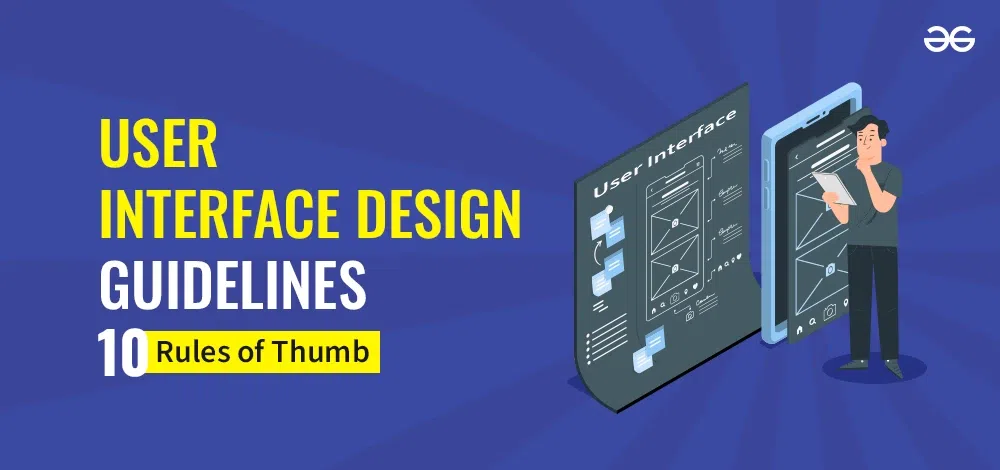User Interface Design Guidelines: 10 Rules of Thumb
Last Updated :
29 Apr, 2024
“User Interface Design Guidelines: The article, “The 10 Principles of Interface Design” has set up an in-depth discussion on how user interfaces should be designed smart, easy to use, and durable time. It gathers the research works and the special interview designs conducted by the human interface designers. From version 1: It pools up the skills and experiences of human interaction designers’ specialists and researchers. It offers 10 useful principles, each containing valuable advice for user satisfaction development goals to build sites like social media, a website, or other digital media platforms. These rules play a vital role in decreasing errors, which occur during the designing process, and allow for less bulky interactions with users.
It enables designers to stay informed of the most current trends and technologies in interface design; a field that seems easy to grasp but is hard to keep up with thanks to its ever-moving nature. Thus, through adherence to these rules, designers can easily design interfaces that solve user’s problems, in addition, they can always make the experience unique and enjoyable. Overall, “User Interface Design Guidelines: “10 Rules” informs the work of seasoned designers on the way to interfaces that are user-friendly, intuitive, and meet customers’ requirements.

User Interface Design Guidelines: 10 Rules of Thumb
What are the 10 user Interface Guidelines?
1. Keep it Simple:
Simplify the design with a clear goal in mind, and limit the complexity and mental load for the user.
2. Be Consistent:
Make the design of the website uniform throughout the pages and consistent in terms of layout, choice of language, and interaction style.
3. Provide Feedback:
Provide an instantaneous response to the users when they perform provided actions so that no mistake is made in the interpretation of the system responses.
4. Prioritize Clarity:
Stress the comprehensive information provided through text, icons, and assessable graphics.
5. Offer Contextual Help:
Develop a user-centric interface, to be able to provide the user with a walking guide when asked to perform tasks.
6. Ensure Accessibility:
First, design interfaces that meet accessibility standards. Do it for your users who are disabled with disabilities.
7. Focus on Navigation:
The interface should be purposeful and interactive, the one that will lead users through the content and effectively complete tasks.
8. Optimize Performance:
Customers first and then speed concerns will be prioritized. This will help reduce the time of completion and also prevent delays.
9. Design for Error Handling:
Low user error rates with simple error messages and helpful recovery options will have to be considered.
10. Iterate and Test:
Iteratively test out engineering and acquire users’ feedback for incorporating them into the interface improving over time.
Uses
- Initial Design Planning: Designers may reference the guidelines as a design roadmap when coming up with screen concepts and creating final designs. The design teams make their way around these standards and keep usability and a nice user experience in mind to achieve them, to begin with, from the start of their design activities.
- Design Evaluation: To increase the level of compliance, the designers must review their work against the set of ten principle, identifying any points that need further improvement. It helps them know through this cycle, if the designs are conflicted with the best practices by pointing out the operational inadequacies.
- Feedback and Iteration: The design teams may well work together or collaborate with others by referring to this rule. Through the helpful comments and suggestions on the rules of the clauses, they can identify a use-ability problem and inconsistency in the design.
Benefits
- Improved Usability: Following the measures described, it becomes possible to develop a prototype that provides all the usability needed by the user, hence making it easy for them to navigate and interact with the product.
- Enhanced User Experience: In all aspects of the online experience, the interface design basics are to be followed, as these will give users an intuitive, pleasant, and comfortable experience, which translates into exceeded satisfaction and retention.
- Consistency Across Platforms: Implementation of design rules, therefore, offers a good way of ensuring interface consistency despite users’ platforms. Thereby, the brand can provide a clear identity that the users can easily identify across the same experience without glitches.
Examples
- Keep it Simple: The main theme of this YouTube video exemplifies the home page of a search engine that has been designed with simplicity and concentration of detail, the search bar being the most noticeable element without other elements to divert users.
- Be Consistent: All webpages have a standard scheme that is similar to others in all layout and design items but still unique which shows consistency in organizing styles, words, and titles.
- Provide Feedback: When the user clicks on the form submission button, its visual cues get changed, for example, to display color varying or the loading animation. These cues help the user to know that the action has taken place.
Conclusion
Briefly, this “10 Golden Rules of Thumb” Volume is a catalog of baseline interface design criteria used in the vast fabric of interactive design for consumer preferences and ease of use. The principles of these rules are straightforward, the development of uniformly applicable solutions, the notification of any user actions, as well as accessibility.
Through many instances and examples in the real world, it manifests the principles that these regulations stand for providing a user-friendly nature of web design which is attracting users’ attention and satisfaction. In designing interfaces the designers need to integrate these concepts and continuously use feedback from the users. This approach sees to it that the interface gets designed in such a way that meets the user’s needs and surpasses the user’s expectations, which, in turn, leads to high user engagement and support.
Share your thoughts in the comments
Please Login to comment...